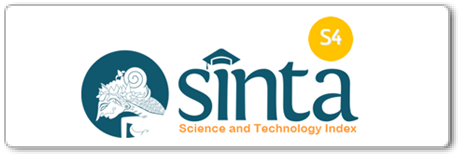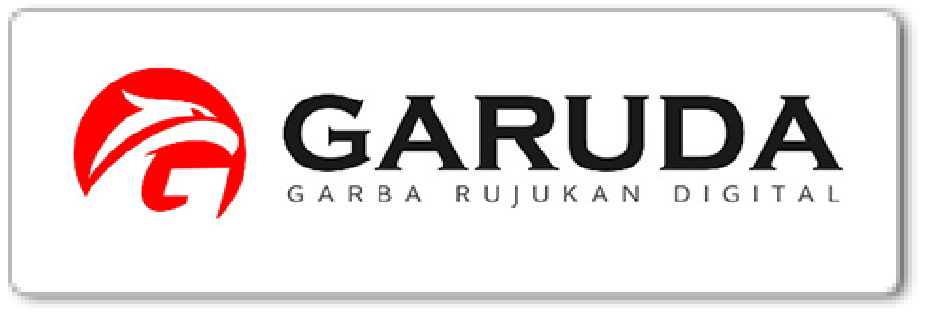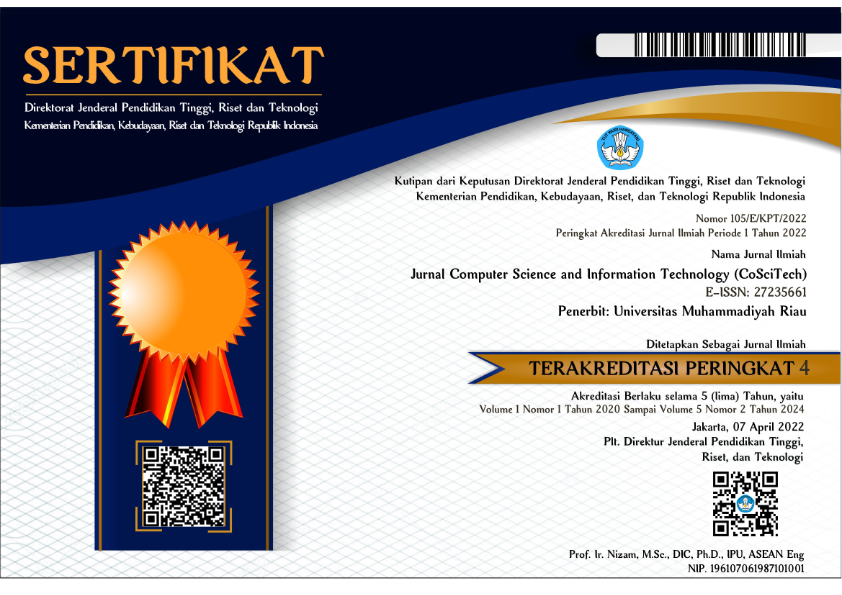Prediction Model for the Number of Machine Lubricant Sales at PT. X With the Naïve Bayes Algorithm
DOI:
 https://doi.org/10.37859/coscitech.v5i3.8250
https://doi.org/10.37859/coscitech.v5i3.8250
Abstract
Machine lubricants are essential materials used to reduce friction between two moving surfaces, improve machine efficiency, and extend the lifespan of components. This study aims to predict the sales volume of machine lubricants at PT. X using the Naïve Bayes algorithm. The data used includes attributes such as year, month, material description, total allocation, realization, and remaining allocation, with a total of 3,006 data points obtained from PT. X's Warehouse Management System (WMS). The model was tested using the 10-Fold Cross Validation method and testsing without such validation. The test results show an accuracy of 71% with 10-Fold Cross Validation, compared to 14% without validation. Additional testing showed an accuracy of 5%, with RMSE of 124.71 and MAPE of 0.95. Based on these results, it is recommended to optimize data preprocessing, such as handling data imbalance and feature normalization, to improve prediction accuracy. Furthermore, using more diverse validation techniques, such as stratified cross-validation, can provide more stable evaluations. Given that predictions are influenced solely by historical data, it is recommended to periodically update the data to keep the model relevant and accurate. This research is expected to assist PT. X in planning sales strategies and managing lubricant stock more effectively.
Downloads
References
[2] Y. Sulindra and E. Herjanto, “STRATEGI PENJUALAN PRODUK PELUMAS PT PPA DENGAN MENGGUNAKAN ANALISIS SWOT.”
[3] R. Jauhari Aisawa Krismanegara, H. Purnomo, U. Nusantara PGRI, J. K. Achmad Dahlan, and K. Jawa Timur, “Seminar Nasional Manajemen, Ekonomi dan Akuntasi Fakultas Ekonomi dan Bisnis UNP Kediri MENINGKATKAN OMZET PENJUALAN MELALUI OPTIMALISASI KUALITAS PRODUK ,VARIASI PRODUK, DAN PERSEPSI HARGA PADA NINDY DEKORASI.”
[4] H. Herman, “Naïve Bayes Classifier dan K-Nearest Neighbor Pada Analisis Sentimen Perkuliahan Daring di Universitas Muslim Indonesia,” 2024, doi: 10.33096/busiti.v5i1.2202.
[5] P. Sofyan Zakaria, R. Julianto, and R. Surya Bernada, “IMPLEMENTASI NAÏVE BAYES MENGGUNAKAN PYTHON DALAM KLASIFIKASI DATA.” [Online]. Available: https://jurnalmahasiswa.com/index.php/biikma
[6] “6498-Article Text-18655-1-10-20231214-2”.
[7] Chely Aulia Misrun, E. Haerani, M. Fikry, and E. Budianita, “Analisis sentimen komentar youtube terhadap Anies Baswedan sebagai bakal calon presiden 2024 menggunakan metode Naïve Bayes classifier,” Jurnal CoSciTech (Computer Science and Information Technology), vol. 4, no. 1, pp. 207–215, Apr. 2023, doi: 10.37859/coscitech.v4i1.4790.
[8] W. Wijiyanto, A. I. Pradana, S. Sopingi, and V. Atina, “Teknik K-Fold Cross Validation untuk Mengevaluasi Kinerja Mahasiswa,” Jurnal Algoritma, vol. 21, no. 1, May 2024, doi: 10.33364/algoritma/v.21-1.1618.
[9] A. Supriyadi Sunge and A. Turmudi Zy, “ANALISIS PREDIKSI PENJUALAN DENGAN METODE REGRESI LINEAR DI PT. EAGLE INDUSTRY INDONESIA,” 2023.
[10] S. M. Hudzaifah et al., “Implementasi Algoritma Naïve Bayes dalam Memprediksi Tingkat Kelulusan Siswa pada Sertifikasi Mikrotik Certified Network Associate (MTCNA),” 2024. [Online]. Available: https://journal.stmiki.ac.id
[11] M. Safii, B. Efendi Damanik, and G. Artikel, “Algoritma Naïve Bayes Untuk Memprediksi Penjualan Pada Toko VJCakes Pematang Siantar Naïve Bayes Algorithm For Predicting Sales at the Pematang Siantar VJCakes Store Article Info ABSTRAK,” JOMLAI: Journal of Machine Learning and Artificial Intelligence, vol. 1, no. 4, pp. 2828–9099, 2022, doi: 10.55123/jomlai.v1i4.1674.
[12] Rovidatul, Y. Yunus, and G. W. Nurcahyo, “Perbandingan algoritma c4.5 dan Naïve Bayes dalam prediksi kelulusan mahasiswa,” Jurnal CoSciTech (Computer Science and Information Technology), vol. 4, no. 1, pp. 193–199, Apr. 2023, doi: 10.37859/coscitech.v4i1.4755.
[13] I. G. A. P. A. Putri and I. N. Nurcaya, “PENERAPAN WAREHOUSE MANAGEMENT SYSTEM PADA PT UNIPLASTINDO INTERBUANA BALI,” E-Jurnal Manajemen Universitas Udayana, vol. 8, no. 12, p. 7216, Dec. 2019, doi: 10.24843/ejmunud.2019.v08.i12.p16.
[14] S. Anwar and H. Lubis, “MENINGKATKAN KUALITAS BIG DATA MELALUI REKAYASA DAN PEMBERSIHAN DATA YANG EFEKTIF.” [Online]. Available: https://www.researchgate.net/publication/376720216
[15] V. T. Heidyanti, “EVALUASI SISTEM MANAJEMEN MUTU DALAM TRANSFORMASI.” [Online]. Available: https://www.researchgate.net/publication/376619056
[16] T. Z. Maulani, Z. K. Simbolon, and A. Amirullah, “ImplementasiAlgoritmaNaïve Bayes ClassifierDalam Menentukan Topik Tugas Akhir Mahasiswa Berbasis Web,” Jurnal Infomedia, vol. 4, no. 1, p. 33, Sep. 2019, doi: 10.30811/jim.v4i1.1107.
[17] W. Abdun Naseer and B. Budi Wahono, “GRADIENT BOOSTING OPTIMIZATION WITH PRUNING TECHNIQUE FOR PREDICTION OF BMT AL-HIKMAH PERMATA CUSTOMER DATA,” Jurnal Informatika Teknologi dan Sains.
[18] N. Aini et al., “Implementasi Algoritma Naïve Bayes untuk Memprediksi Penjualan Lampu Pada Toko Satria,” INNOVATIVE: Journal Of Social Science Research, vol. 3, pp. 9373–9387, 2023.
[19] I. Widhi Saputro and B. Wulan Sari, “Uji Performa Algoritma Naïve Bayes untuk Prediksi Masa Studi Mahasiswa Naïve Bayes Algorithm Performance Test for Student Study Prediction,” Citec Journal, vol. 6, no. 1, 2019.
[20] D. Arisandi and T. Sutrisno, “EVALUASI PENILAIAN KINERJA KARYAWAN DENGAN METODE NAÏVE BAYES,” 2024.
[21] T. Rivanie, R. Pebrianto, T. Hidayat, A. Bayhaqy, W. Gata, and B. Novitasari, “ANALISIS SENTIMEN TERHADAP KINERJA MENTERI KESEHATAN INDONESIA SELAMA PANDEMI COVID-19,” 2021.
[22] F. Hayatun Nufus, G. Santoso, A. Al Bahij, and U. Muhammadiyah Jakarta, “Pengembangan Karakter Kreatif Dalam Menghadapi Tantangan Abad 21,” 2023.
[23] A. Azkiya, O. Rohaeni, F. Badruzzaman, and E. Harahap, “Analisis Peramalan Penjualan Produk X Pada Perusahaan XYZ Menggunakan Metode Double Exponential Smoothing Forecasting Analysis of Product X Sales at Company XYZ Using Double Exponential Smoothing Method,” vol. 22, no. 2, 2023.
[24] “Lampiran 5”.
[25] I. Gede, I. Sudipa, and M. Darmawiguna, “BUKU AJAR DATA MINING.” [Online]. Available: https://www.researchgate.net/publication/377415198
[26] C. Herdian, A. Kamila, and I. G. Agung Musa Budidarma, “Studi Kasus Feature Engineering Untuk Data Teks: Perbandingan Label Encoding dan One-Hot Encoding Pada Metode Linear Regresi,” Technologia : Jurnal Ilmiah, vol. 15, no. 1, p. 93, Jan. 2024, doi: 10.31602/tji.v15i1.13457.
[27] A. P. Sukma Wahyu et al., “PENERAPAN ALGORITMA NAÏVE BAYES CLASSIFICATION UNTUK KLASIFIKASI SENTIMENT TWEET TERHADAP PLATFORM STREAMING ILEGAL,” Jurnal informasi dan Komputer, vol. 11, no. 2, p. 2023.
[28] W. Wijiyanto, A. I. Pradana, S. Sopingi, and V. Atina, “Teknik K-Fold Cross Validation untuk Mengevaluasi Kinerja Mahasiswa,” Jurnal Algoritma, vol. 21, no. 1, May 2024, doi: 10.33364/algoritma/v.21-1.1618.













